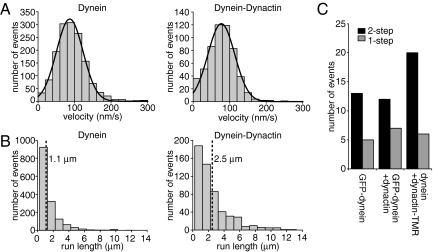Fig. 2.
Single dynein–dynactin complexes exhibit robust minus-end-directed motility with enhanced processivity. (A) Histograms of dynein and dynein–dynactin velocities. The velocity of dynein is 87 ± 36 nm/s (mean ± SD; n = 1499), and the velocity of dynein–dynactin is 77 ± 37 nm/s (n = 560). Curved lines represent Gaussian fits of the data. A few outlying points are truncated from histograms of run lengths and velocity for display purposes. (B) Histograms of dynein and dynein–dynactin run lengths. The run length of dynein is 1.15 ± 0.04 μm (mean ± SE), and the run length of dynein–dynactin is 2.54 ± 0.17 μm (determined from cumulative probability functions; see Fig. S2). Dashed lines indicate the mean. (C) Histogram of bleaching events. All bleaching events observed occurred in 1 or 2 steps. GFP-dynein, n = 18; GFP-dynein–dynactin, n = 19; dynein–dynactin-TMR, n = 26.

